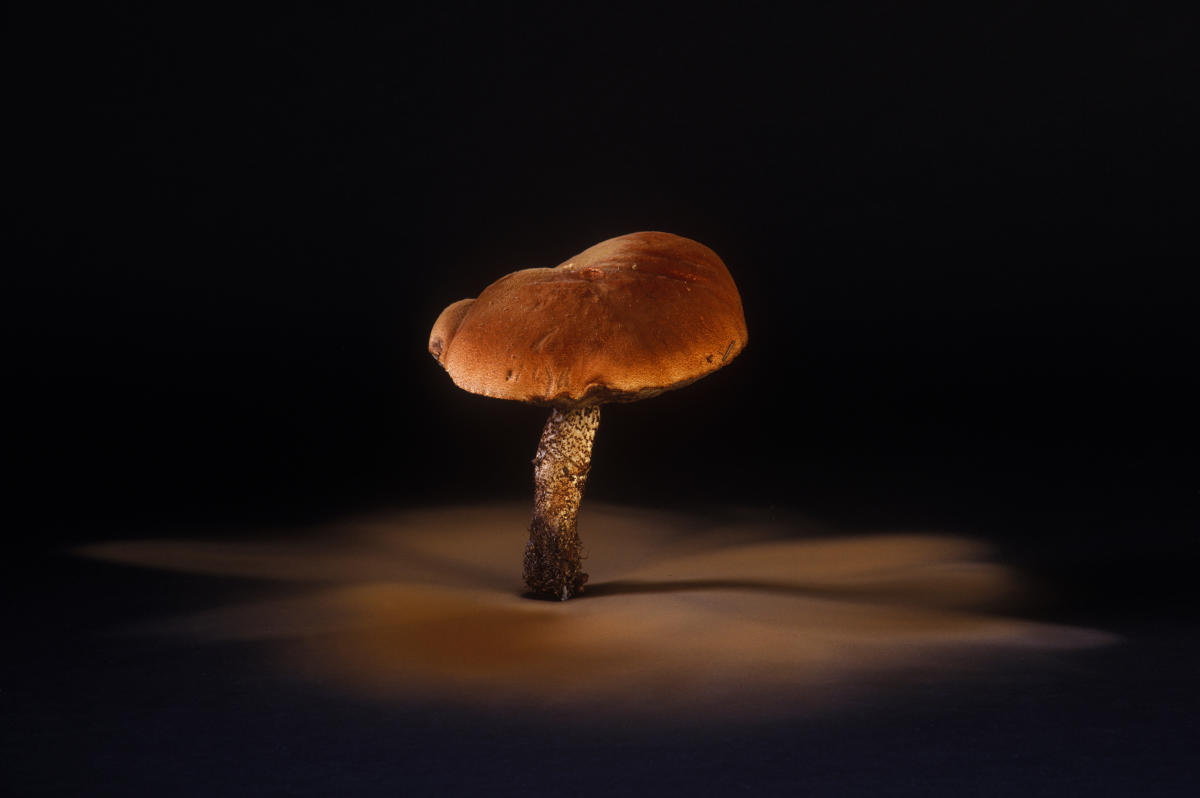Orange oak fungus
Orange porcini (Leccinum quercinum) showing spore dispersal pattern over 24 hours on black board. Credit – Yves Lanceau – Nature Pictures Library
You’ve probably heard of “zombie mushrooms,” which are capable of simulating the behavior of their host insects with great precision. such a mushroom Ophiocordyceps unilateralis, infects carpenter ants. Once infected with the fungus, ants lose their instinctive fear of heights and climb onto the nearest plant. In due course, the fungus will force the ant to clamp its jaws around the plant in a “death grip”. The fungus then digests the ant’s body and projects a stalk-like structure from its head, from which spores rain down onto the ants passing below.
Unlike the fictional killer zombie mushrooms in the recent post-apocalyptic HBO series, The last of usZombie fungi have never been found to infect mammals. But no wonder they stimulate our imagination: when you think of mushrooms, the world looks different. Mushrooms form one of the kingdoms of life – a category as broad as “animals” or “plants” – and hold the key to understanding the planet we live on. They are in you and around you. They get you and everything you need. As you read these words, fungi make soil, produce food, make medicines, feed and kill animals and plants, and affect the composition of the Earth’s atmosphere.
Mushroom facts are more remarkable than mushroom fictions. And as we look to the future of life on a degraded planet, what can we do to nurture fruitful relationships with this amazing and vastly diverse group of organisms?
Continue reading: How HBO’s The Last of Us attempts to capture the video game’s complex morality
Most fungi live most of their lives not as fungi, but as branching, merging networks of tubular cells known as mycelium. Mycelial networks do not have a fixed shape. By transforming themselves, they can navigate mazes and expertly explore their surroundings. Globally, the total length of the fungal mycelium in the top 10 centimeters of soil is more than 450,000 trillion kilometers: about half the width of our galaxy. Most plants depend on symbiotic fungi to weave their way through roots and leaves, providing plants with essential nutrients and protecting them from disease and drought. Bacteria use fungal networks as highways to navigate the soil’s crowded putrefactive landscapes. Of the carbon found in soil – twice that found in plants and the atmosphere combined – a significant portion is locked up in tough organic compounds produced by fungi. Fungal networks comprise an ancient life support system that can easily be qualified as one of the wonders of the living world.
The growing interest in mushrooms is welcome and long overdue. But why now? What has led to the current surge in mushroom fascination? Exciting new research, made possible by technologies such as DNA sequencing, plays a major role; Today, more than ever, we are better equipped to unravel its mysteries and understand its complexities. Exciting fungal discoveries have found receptive audiences in part due to a growing awareness of the living world’s interconnectivity. Mushrooms are powerful reminders of the intimate, reciprocal relationships that sustain all life. In addition, fungi are good poster organisms for network thinking: the recent surge in public interest in fungi has coincided with the emergence of network concepts in many disciplines, from computer science, sociology, and neuroscience to economics and astronomy.
But perhaps the most powerful driver behind the general interest in mushrooms has been the growing awareness of the many ways we can work with mushrooms to adapt to deepening environmental and public health crises. Mushrooms are metabolic wizards, and their chemical advances have long shaped human life: bread, cheese, soy sauce, penicillin, a variety of powerful antiviral and anticancer compounds, cholesterol-lowering statins, and immunosuppressive drugs that make organ transplants possible — not to mention alcohol (fermented by yeast) and psilocybin (the psychoactive component in psychedelic mushrooms that shows promise in treating major depression and anxiety). The insatiable appetite of mushrooms can be used to break down pollutants such as crude oil from oil spills in a process known as mycoremediation. In mycofabrication, building materials and textiles can be grown from mycelium and used as a substitute for plastics and leather.
Continue reading: Are Mushrooms Healthy? Here’s what experts say
Although fungi are important allies for humans, it’s also true that a small minority can cause big problems. Fungal infections kill about 2 million people annually. Fungal diseases of crops result in billions of dollars in losses – the rice blast fungus ruins a crop of rice large enough to feed more than 60 million people each year. Tree fungal diseases, from Dutch elm disease to chestnut blight, are changing forests and landscapes. The impact of fungal diseases is increasing worldwide due to trade and unsustainable agricultural practices, and the widespread use of antifungal drugs has led to an unprecedented rise in new fungal superbugs threatening both human and plant health.
Given that we have no choice but to interact with fungi, how can we ensure a healthy future with them?
First, fungi need to be included in conservation frameworks. Fungi play an important role in supporting planetary biodiversity. If we disturb them, we endanger the health and resilience of the organisms we all depend on. Despite the fact that we are destroying the planet’s fungal communities at an alarming rate, most environmental laws and international conventions such as the Convention on International Trade in Endangered Species of Wild Fauna and Flora (CITES) or the United Nations Convention on Biological Diversity ( CBD) along with many major international NGOs relate to the conservation of flora (plants) and fauna (Animals). Add “F” in third place, Mushroom, Adding it to the list would rewrite this neglected realm of life into the framework of conservation and agricultural policies and free up critical funds for mycological research, surveys, and educational programs.
We also need to invest in mushroom research. Mushrooms are a kingdom of life that doesn’t deserve a kingdom’s attention, and our ignorance is easily summed up. Current estimates assume that less than 10% of all fungal species have been described. It wasn’t until 1969 that fungi were recognized as a distinct kingdom of life, leading to a disciplinary bias: There are fewer ways to study fungi than animals and plants. Although fungal pathogens are on the rise, vaccines against fungal infections have not been developed and the small number of existing antifungal drugs are becoming increasingly ineffective. A deeper understanding of fungal life will support important conservation and restoration projects, and also drive much-needed innovation in fungal technologies.
Above all, we must invest in fungal growth. Mushrooms are largely absent from school and undergraduate curricula, which perpetuates our mushroom blindness and actively distorts our worldview. Accounts of the living world that do not include fungi are accounts of a world that does not exist.
Mushrooms have long sustained and enriched life on earth. We are unthinkable without them, and yet we are only just beginning to understand the intricacies of mushroom life. It’s time to give them the attention they deserve.
Don’t miss interesting posts on Famousbio










